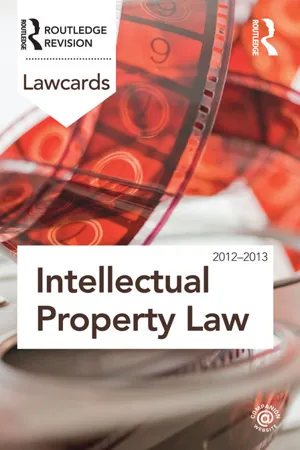![]()
Introduction
Intellectual property law deals with the formulation, usage and subsequent commercial exploitation of original creative labour. The areas outlined within this book form some type of proprietary protection over intangibles such as inventions and information.
Much of the debate revolves around how the boundary lines of intangible property are defined; this is an important aspect as intellectual property protects a wide and often valuable range of goods. Intellectual property is a rapidly moving and often topical area, with some of the recent debates revolving around GM food, gene patenting, peer-to-peer networks such as KaZaA and the 2005 legislation concerning the copyright regime.
It is important to ‘hang’ new legal developments onto the tenets of law. To this end this book contains up to date examples of recent case and statute law.
![]()
Confidential information
Basic elements of breach of confidence | |
Categories of protectable information | |
The essential elements of breach of confidence; information, obligation of confidence and risk of damage | |
The public interest defence | |
| Remedies: damages and injunctions | |
THE ACTION FOR BREACH OF CONFIDENCE – BASIC ELEMENTS
The basis for an action for breach of confidence may lie in equity or contract or at common law.
No right to privacy under English common law exists, although Art 8 of the European Convention on Human Rights seeks to guarantee a limited right with respect to the private life of individuals and families and to protect private correspondence. However, balanced against this is Art 10 which guarantees freedom of expression (see Douglas v Hello! Ltd [2001], (No. 3) [2003], (No. 8) [2004]).
The action for breach of confidence is broad ranging. It covers personal and technical trade secrets, knowhow and ideas.
Commentators have long discussed whether breach of confidence arises from one of the following doctrines:
This question may be of importance when a conflict of laws arises and when limitation periods are in dispute.
In Kitechnology BV v Unicor GmbH Plastmaschinen [1995] it was said that claims for breach of confidentiality did not arise in tort or contract, but were part of equity.
Breach of confidence is comprised almost entirely of case law; however, there is statutory recognition in s 171(1) of the Copyright, Designs and Patents Act (CDPA) 1988 and s 1 of the Official Secrets Act 1989.
CATEGORIES OF PROTECTABLE INFORMATION
To be protected, information must have ‘the necessary quality of confidence about it, namely, it must not be something which is public property and public knowledge’ (per Lord Greene MR in Saltman Engineering Co Ltd v Campbell Engineering Co Ltd [1963]).
Examples
In Coco Engineers v Clark [1969], Megarry VC expressed the view that the doctrine of confidential information would only be used in cases of sufficient gravity, and not mere ‘tittle-tattle’. Matters that are revealed to the public, such as by a court case, cease to be private (Chantry Martin v Martin [1953]).
A person receiving confidential information is still under an obligation of confidence, even if he already knows the information (Johnson v Heat and Air Systems Ltd [1941]).
However, confidentiality may still be maintained even though the information has been published, to prevent further damage through repetition (see Schering Chemicals v Falman Ltd [1982]).
Liability may sometimes attach to recipients who innocently acquire confidential information; liability arises at the time a party is informed of the breach of confidence (see Stephenson, Jordan and Harrison Ltd v Macdonald and Evans [1952]; Printers and Finishers Ltd v Holloway (No 2) [1965]).
COCO V CLARK: THE THREE ESSENTIAL ELEMENTS THAT ESTABLISH BREACH OF CONFIDENCE
The broadly worded formulations for the elements of breach of confidence, adopted by the courts in the past, have tended to encourage claimants. In Coco, Megarry VC held the following to be necessary for an action:
(a) Important information capable of protection: the information must have a necessary element of confidentiality.
(b) Obligation of confidence: the information was communicated in circumstances where the confidant ought reasonably to have known that the disclosure had been made in confidence.
(c) Risk of damage: there is a risk of the information being used or disclosed in an unauthorised way, possibly causing damage.
The Coco case is an important case and is frequently cited. Coco partly followed the approach of the Court of Appeal in Saltman Engineering Co Ltd v Campbell Engineering Co Ltd [1948]. There is no need for an obligation of confidence to be in writing, as the courts have been prepared to imply terms.
Note that in the case of prototypes, ideas, personal secrets and employment, the three essential elements of Coco must be established in each situation.
Prototypes
Designs, prototypes or product samples shown to others prior to any business deal may be protected, but subject to the decision in Carflow Products (UK) Ltd v Linwood Securities (Birmingham) Ltd and Others [1996], where the court refused to impose an obligation of confidence on the party viewing the sample.
It was held that there are two possible approaches to the question of whether a disclosure was in confidence:
(a) subjective, that is, what did the parties themselves think they were doing by way of imposing or accepting obligations?; and
(b) objective, that is, what would a reasonable man think they were doing?
As equity looked at the conscience of the individual, the subjective view was the appropriate one.
The mere fact that a prototype was being offered for sale did not import an obligation of confidence.
In a passage from the Coco case, Megarry J suggested that an objective test could apply in situations where:
... information of commercial or industrial value is given on a businesslike basis and with some avowed common object in mind, such as a joint venture or the manufacture of articles by one party for the other.
He stated that he...













